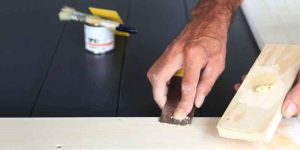Wood filler typically lasts for several years once opened, but the exact lifespan can vary depending on factors such as the quality of the filler and how it is stored. Properly sealed and stored wood filler can last for a longer period of time, while exposure to moisture or extreme temperatures can shorten its lifespan.
Taking these precautions can help extend the lifespan of your wood filler and ensure its effectiveness for future use. Wood filler is a versatile product that is commonly used in woodworking projects and repairs. Whether you need to fill cracks, holes, or gaps in wood surfaces, wood filler can come in handy.
However, it is important to know how long wood filler lasts to ensure its effectiveness and reliability. We will explore the factors that influence the lifespan of wood filler, as well as some tips to prolong its usability. By understanding the longevity of wood filler, you can make informed decisions when using it for your woodworking needs.
Factors Affecting Longevity
Wood filler longevity depends on factors like storage conditions and product quality. Properly sealed wood filler can last for years, maintaining its effectiveness. Quality products tend to have a longer shelf life, providing durable repairs over time.
Environmental Factors
Environmental factors play a crucial role in determining the longevity of wood filler. The exposure to moisture, temperature fluctuations, and UV rays can all impact the durability of the wood filler. Moisture can cause wood filler to soften and degrade over time, leading to cracks and shrinkage. Similarly, extreme temperature changes can also cause the filler to expand and contract, leading to cracks and gaps.
Quality Of Wood Filler
The quality of the wood filler itself is another important factor that affects its longevity. High-quality wood fillers typically contain substances that make them resistant to moisture, UV rays, and temperature changes. These fillers are designed to withstand the effects of aging and weathering, ensuring a longer-lasting repair. On the other hand, low-quality fillers may degrade more quickly, resulting in the need for frequent repairs or replacements.
Application Method
The method used to apply the wood filler can also impact its longevity. Proper application techniques ensure that the filler is evenly distributed and securely bonded to the wood surface. This helps prevent cracks, gaps, and separation over time. It is important to follow the manufacturer’s instructions and use the recommended tools for application to ensure optimal adhesion and longevity of the wood filler.
Signs Of Deterioration
Wood filler can deteriorate over time, showing signs of its age. Keep an eye out for shrinking, cracking, and discoloration to determine if your wood filler is still effective.
Shrinking
One visible sign of deteriorating wood filler is shrinkage. If you notice the filler sinking or pulling away from the surface it was applied to, it may be time to replace it.
Cracking
Cracks in the wood filler indicate that it is no longer adhering properly to the wood surface. Cracking can compromise the structural integrity of the repair and should be addressed promptly.
Discoloration
Discoloration of wood filler can signal decay or moisture damage. If you notice any changes in color that are not part of the filler’s natural aging process, it may be time to replace it.
Maximizing Wood Filler Lifespan
To maximize the lifespan of wood filler, it is important to choose a high-quality product and properly store it in a cool, dry place. Additionally, applying a protective finish over the wood filler can help to prevent cracking and extend its durability.
Proper Storage
Store wood filler in a cool, dry place away from direct sunlight to prevent it from drying out prematurely.
Sealing Opened Containers
Ensure to seal opened containers tightly after each use to maintain the quality of the wood filler.
Choosing The Right Type
- Select the appropriate type of wood filler based on the nature of your project to enhance its longevity.
Comparing Wood Putty And Wood Filler
When it comes to repairing or restoring wood surfaces, using wood putty or wood filler can be the perfect solution. However, it’s important to understand the differences between these two products to ensure you choose the right one for your specific project. In this section, we will explore the composition and suitability of wood putty and wood filler, helping you make an informed decision.
Differences In Composition
Wood putty and wood filler may seem similar, but they have distinct differences in their composition. Wood putty is typically a combination of wood fibers and a binder, such as epoxy or polyurethane. This composition allows the putty to be easily molded and shaped to fill small gaps or cracks in wood surfaces. On the other hand, wood filler is made from a combination of wood fibers and a binder, such as vinyl or cellulose. The filler is designed to be thicker and more substantial, making it suitable for filling larger voids or repairing damaged wood.
Suitability For Specific Projects
Choosing the right product for your project is crucial to ensure long-lasting and durable results. Wood putty is best suited for smaller repairs and projects where the wood surface is finished. Its ability to be easily molded and shaped makes it great for filling nail holes, minor cracks, or imperfections in finished wood surfaces. Wood filler, on the other hand, is more suitable for larger repairs and projects on unfinished wood surfaces. Its thicker consistency provides structural support and strength, making it ideal for filling deep cracks, gouges, or rot in untreated wood.
In summary:
- Wood putty is best for small repairs on finished wood surfaces.
- Wood filler is ideal for larger repairs on unfinished wood surfaces.
Ultimately, your choice between wood putty and wood filler will depend on the specific requirements of your project. Consider the size and nature of the repair, as well as whether the wood surface is finished or unfinished. By understanding the differences in composition and suitability, you can confidently select the right product to achieve the desired results for your wood restoration or repair project.
Understanding Drying Times
When working with wood filler, understanding its drying times is crucial to achieving a successful finish. Knowing the normal drying duration, the factors influencing the drying process, and the optimal sanding time are essential for achieving a smooth and seamless result.
Normal Drying Duration
The normal drying duration of wood filler can vary depending on various factors such as the type of filler, humidity, and temperature. Generally, most wood fillers require around 2-6 hours to dry completely. However, it’s important to refer to the manufacturer’s instructions for specific guidance on drying times for the product you are using.
Factors Influencing Drying
Several factors can influence the drying time of wood fillers. Humidity and temperature play a significant role, as high humidity and low temperatures can prolong the drying process. Additionally, the type and thickness of the filler applied can impact drying times. Thicker applications may require more time to dry thoroughly.
Optimal Sanding Time
The optimal sanding time for wood filler is typically after it has fully dried. Sanding too early can result in a gummy or uneven surface, while waiting too long may make the filler difficult to sand. As a general guideline, it is best to wait at least 24 hours before sanding the wood filler to ensure a smooth and even finish.
Expert Recommendations
When it comes to expert recommendations for using wood filler, there are essential tips and precautions to keep in mind. By following these expert suggestions, you can ensure the longevity and effectiveness of your wood filler. Here’s a comprehensive guide to expert recommendations for using wood filler:
Tips For Usage
- Mix the wood filler thoroughly before application.
- Apply the filler in thin layers to prevent cracking and ensure proper adhesion.
- Sand the filled area after it has dried to achieve a smooth finish.
- Use latex gloves when working with wood filler to protect your skin.
- Choose a high-quality wood filler that matches the color and type of your wood for the best results.
Precautions To Prevent Issues
- Store wood filler in a cool, dry place to prevent it from drying out prematurely.
- Avoid using excess water or solvent when mixing the wood filler, as it can affect the drying time and adhesion.
- Do not apply wood filler to damp or wet wood, as it may not adhere properly and can lead to mold or mildew issues.
- Ensure proper ventilation when working with wood filler to avoid inhaling harmful fumes.
- Always follow the manufacturer’s instructions for the specific wood filler you are using.

Frequently Asked Questions Of How Long Does Wood Filler Last
Is Wood Filler Permanent?
Yes, wood filler is permanent. A product like Minwax® High Performance Wood Filler permanently repairs damaged and rotted wood. It is used to fill gouges and holes in split, damaged or rotted exterior or interior woods.
How Long Does Wood Filler Last Once Opened?
Once opened, wood filler can last up to 1 year with proper sealing.
Does Wood Filler Crack Over Time?
Wood filler can crack over time, especially when exposed to fluctuating temperatures. It is not recommended for outdoor use.
Which Is Better Wood Putty Or Wood Filler?
Wood filler is better for unfinished wood, while wood putty is suitable for finished wood surfaces.
Conclusion
The longevity of wood filler depends on various factors such as the quality of the product, the application method, and the environment it is exposed to. While some wood fillers can last for several years without any issues, others may start to crack or shrink over time.
It is important to choose a high-quality wood filler and follow proper application techniques to ensure the best results. Regular inspection and maintenance can also help prolong the lifespan of wood filler.


